 IAS on Facebook IAS on Facebook
 IAS on Instagram IAS on Instagram

|

IAS Aroid Quasi Forum
About Aroid-L
This is a continuously updated archive of the Aroid-L mailing list in a forum format - not an actual Forum. If you want to post, you will still need to register for the Aroid-L mailing list and send your postings by e-mail for moderation in the normal way.
|
Aglaomena & Amerindian plants & Anoucha
|
From: Johannes Moonen <emeraldjunglevillage at wanadoo.fr> on 2010.11.01 at 12:30:27(21603)
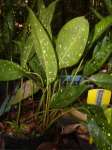
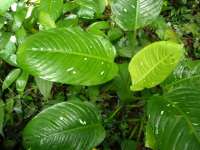
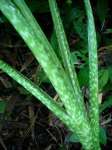
Dear Eduardo & friends,
This plant in my collection in Guayana Francesca looks like the Aglaomena or Bognera in Santourys mail. I collected it locally but did not register where. I often collect plants on tourist trips but have not allways the time to write things down.
Dieffenbachia spec FG.
I think these Dieffenbachias on the coest of FG are also of Amerindian origin.
Detail of the same Dieffenbachia. They grow among other Amerindian plants like Caladiums etc.
At least a picture of Anoucha that went on our last Oiapogue expedition in September. She is a hunting victim, confiscated by IBAMA and given to our boatsman to raise. She is adorable.
have a nice day, tchao Joep
--Apple-Mail-58-1069782570
| HTML +More |
Content-Disposition: inline;
filename=DSCN2161.jpg
Content-Transfer-Encoding: base64 |
|
From: santoury at aol.com on 2010.11.01 at 16:41:50(21607)
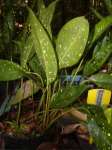
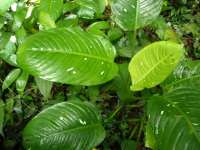
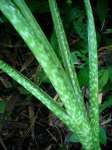
Hello
The first picture looks identical to my Aglaonema which has been identified as A. brevispathum hospitum.
The monkey is gorgeous - what type is she? Thank you for sharing! That Dieffenbachia is something else. I love it!
| HTML +More | |
-----Original Message-----
From: Johannes Moonen
To: Discussion of aroids
Sent: Mon, Nov 1, 2010 8:30 am
Subject: [Aroid-l] Aglaomena & Amerindian plants & Anoucha
Dear Eduardo & friends,
This plant in my collection in Guayana Francesca looks like the Aglaomena or Bognera in Santourys mail. I collected it locally but did not register where. I often collect plants on tourist trips but have not allways the time to write things down.
Dieffenbachia spec FG.
I think these Dieffenbachias on the coest of FG are also of Amerindian origin.
Detail of the same Dieffenbachia. They grow among other Amerindian plants like Caladiums etc.
At least a picture of Anoucha that went on our last Oiapogue expedition in September. She is a hunting victim, confiscated by IBAMA and given to our boatsman to raise. She is adorable.
have a nice day, tchao Joep
=
_______________________________________________
Aroid-L mailing list
Aroid-L@www.gizmoworks.com
http://www.gizmoworks.com/mailman/listinfo/aroid-l
----------MB_8CD47FAD0EFB76D_80C_1DD6_Webmail-m122.sysops.aol.com
Content-ID:
Content-Transfer-Encoding: base64
Content-Disposition: inline |
|
From: "Tom Croat" <Thomas.Croat at mobot.org> on 2010.11.02 at 02:25:38(21613)
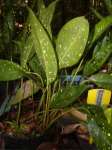
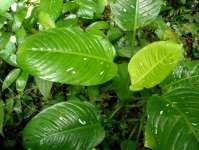
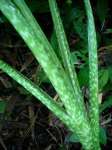
Dear Joep:
I think that I have two
species in the Guianas if I am not misremembering. One of them is probably D.
spruceana or at least a very close relative.
Tom
| HTML +More | |
From:
aroid-l-bounces@www.gizmoworks.com [mailto:aroid-l-bounces@www.gizmoworks.com] On Behalf Of santoury@aol.com
Sent: Monday, November 01, 2010
11:42 AM
To: aroid-l@www.gizmoworks.com
Subject: Re: [Aroid-l] Aglaomena
& Amerindian plants & Anoucha
Hello
The first picture looks identical to my
Aglaonema which has been identified as A. brevispathum
hospitum.
The monkey is gorgeous - what type is
she? Thank you for sharing! That Dieffenbachia is something else. I love
it!
-----Original
Message-----
From: Johannes Moonen
To: Discussion of aroids
Sent: Mon, Nov 1, 2010 8:30 am
Subject: [Aroid-l] Aglaomena & Amerindian plants & Anoucha
Dear Eduardo &
friends,
This plant in my
collection in Guayana Francesca looks like the Aglaomena or Bognera in
Santourys mail. I collected it locally but did not register where. I often
collect plants on tourist trips but have not allways the time to write things
down.
Dieffenbachia spec
FG.
I think these
Dieffenbachias on the coest of FG are also of Amerindian origin.
Detail
of the same Dieffenbachia. They grow among other Amerindian plants like Caladiums
etc.
At
least a picture of Anoucha that went on our last Oiapogue expedition in
September. She is a hunting victim, confiscated by IBAMA and given to our
boatsman to raise. She is adorable.
have a nice day,
tchao Joep
=
_______________________________________________
Aroid-L mailing list
Aroid-L@www.gizmoworks.com
href="http://www.gizmoworks.com/mailman/listinfo/aroid-l" target="_blank">http://www.gizmoworks.com/mailman/listinfo/aroid-l
------_=_NextPart_002_01CB7A35.3D3F9DA7--
------_=_NextPart_001_01CB7A35.3D3F9DA7 |
|
From: Peter Boyce <phymatarum at googlemail.com> on 2010.11.02 at 02:28:25(21614)
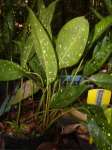

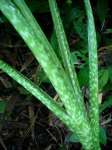
I agree. Exactly the same as I have seen in Thailand (where it
is wild on forested limestone escarpments) and in cultivation throughout
Malaysia where its tough constitution makes it very popular with the owners of
coffee shops to decorate their yards. | HTML +More | |
From: aroid-l-bounces@www.gizmoworks.com
[mailto:aroid-l-bounces@www.gizmoworks.com] On Behalf Of santoury@aol.com
Sent: Tuesday, 2 November, 2010 12:42 AM
To: aroid-l@www.gizmoworks.com
Subject: Re: [Aroid-l] Aglaomena & Amerindian plants & Anoucha
Hello
The first picture looks identical to my Aglaonema which has been
identified as A. brevispathum hospitum.
The monkey is gorgeous - what type is she? Thank you for sharing!
That Dieffenbachia is something else. I love it!
-----Original Message-----
From: Johannes Moonen
To: Discussion of aroids
Sent: Mon, Nov 1, 2010 8:30 am
Subject: [Aroid-l] Aglaomena & Amerindian plants & Anoucha
Dear Eduardo & friends,
This plant in my collection in Guayana Francesca looks like the
Aglaomena or Bognera in Santourys mail. I collected it locally but did not
register where. I often collect plants on tourist trips but have not allways
the time to write things down.
Dieffenbachia spec FG.
I think these Dieffenbachias on the coest of FG are also of
Amerindian origin.
Detail of the same
Dieffenbachia. They grow among other Amerindian plants like Caladiums etc.
At least a picture of
Anoucha that went on our last Oiapogue expedition in September. She is a
hunting victim, confiscated by IBAMA and given to our boatsman to raise. She is
adorable.
have a nice day, tchao Joep
=
_______________________________________________
Aroid-L mailing list
href="mailto:Aroid-L@www.gizmoworks.com">Aroid-L@www.gizmoworks.com
href="http://www.gizmoworks.com/mailman/listinfo/aroid-l" target="_blank">http://www.gizmoworks.com/mailman/listinfo/aroid-l
------=_NextPart_001_00BE_01CB7A78.B1080C70--
------=_NextPart_000_00BD_01CB7A78.B1080C70 |
|
From: Johannes Moonen <emeraldjunglevillage at wanadoo.fr> on 2010.11.02 at 10:23:45(21620)
Hi Jude & all,
Good to know it is Aglaomena brevispathum !
Dieffenbachia's are still a badly known group of Araceae.
I think there are real wild ones in the rainforest like D humilis.
But others, especially on the coastal area grow where Amerindians have lived and are likely culture plants that survived after the Arowaks? moved.
The monkey is a black spider monkey or kwata (Atelis paniscus).
It lives only in undisturbed rainforest, families of about 6 - 8 and is a very important seed disperser.
They are the most 'human' of the 8 species of monkeys in the Guianas. They have only 4 fingers (the thumb is missing) on the hands, but have a real finger on the end of the tail. The males have a strong territorial call, almost as loud as howler monkeys, but kwatas screem only during the day.
Back to aroids, tchao, Joep
| HTML +More |
On Nov 1, 2010, at 1:41 PM, santoury@aol.com wrote:
Hello
The first picture looks identical to my Aglaonema which has been identified as A. brevispathum hospitum.
The monkey is gorgeous - what type is she? Thank you for sharing! That Dieffenbachia is something else. I love it!
-----Original Message-----
From: Johannes Moonen
To: Discussion of aroids
Sent: Mon, Nov 1, 2010 8:30 am
Subject: [Aroid-l] Aglaomena & Amerindian plants & Anoucha
Dear Eduardo & friends,
This plant in my collection in Guayana Francesca looks like the Aglaomena or Bognera in Santourys mail. I collected it locally but did not register where. I often collect plants on tourist trips but have not allways the time to write things down.
Dieffenbachia spec FG.
I think these Dieffenbachias on the coest of FG are also of Amerindian origin.
Detail of the same Dieffenbachia. They grow among other Amerindian plants like Caladiums etc.
At least a picture of Anoucha that went on our last Oiapogue expedition in September. She is a hunting victim, confiscated by IBAMA and given to our boatsman to raise. She is adorable.
have a nice day, tchao Joep
=
_______________________________________________
Aroid-L mailing list
Aroid-L@www.gizmoworks.com
http://www.gizmoworks.com/mailman/listinfo/aroid-l
_______________________________________________
Aroid-L mailing list
Aroid-L@www.gizmoworks.com
http://www.gizmoworks.com/mailman/listinfo/aroid-l
--Apple-Mail-2--998903211--
--=============='35058750151224502=� |
|
From: "Eduardo" <eduardo.goncalves at inhotim.org.br> on 2010.11.02 at 14:16:39(21622)
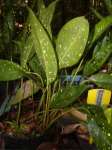
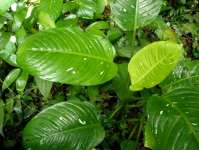
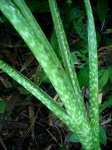
Dear Joep,
The Aglaonema you collected in the French Guiana trail is
probably Aglaonema brevispathum, another common species cultivated by Indians in
South America. Together with A. costata, the native but domesticated forms of Caladium
(specially of the C. picturatum group) and a few other plants, these species
are kept by Indians (or strongy Indian influenced communities) as special
plants and given as gifts to just married couples as a good-luck charms. Probably
these plants were brought by Chinese and Indians (from India) that came for
special jobs (like railways or mining activities) and spread by local people. Years
after, we find this weird things in the middle of “virgin”jungle in
South America!
Very best wishes,
Eduardo.
| HTML +More | |
INHOTIM
Dr.
EDUARDO G. GON�ALVES
Curador Bot�nico
Jardim Bot�nico
Rua B, 20
35460-000 | Brumadinho | MG | Brasil
+55 31 3571.6638 Ramal Fixo 107
+55 31 9604.8618 Ramal 380
Rua
Ant�nio de Albuquerque, 215 | Funcion�rios
30112-010 | Belo Horizonte | MG | Brasil
+55 31 3223.8224
Antes de imprimir,
pense em sua responsabilidade com o Meio Ambiente.
De:
aroid-l-bounces@www.gizmoworks.com [mailto:aroid-l-bounces@www.gizmoworks.com] Em
nome de Johannes Moonen
Enviada em: segunda-feira, 1 de novembro de 2010 10:30
Para: Discussion of aroids
Assunto: [Aroid-l] Aglaomena & Amerindian plants & Anoucha
Dear Eduardo & friends,
This plant in my collection in Guayana Francesca looks like
the Aglaomena or Bognera in Santourys mail. I collected it locally but did
not register where. I often collect plants on tourist trips but have not
allways the time to write things down.
Dieffenbachia
spec FG.
I think these Dieffenbachias on the coest of FG are also of
Amerindian origin.
Detail
of the same Dieffenbachia. They grow among other Amerindian plants like
Caladiums etc.
At
least a picture of Anoucha that went on our last Oiapogue expedition in
September. She is a hunting victim, confiscated by IBAMA and given to our
boatsman to raise. She is adorable.
have a nice day,
tchao Joep
------=_NextPart_001_0032_01CB7A87.D118FB00--
------=_NextPart_000_0031_01CB7A87.D118FB00 |
|
From: Johannes Moonen <emeraldjunglevillage at wanadoo.fr> on 2010.11.03 at 10:44:44(21632)
Bom Dia Eduardo,
Indeed it is amazing how people carry plants around the globe.
Do you know the origin (and the name ?) of the fine Amerindian bambu that you find in the middle of the rainforest ? The french call them 'cambrouses'. From the air they are bright green places in the forest and they are without exeption old Amerindian settlements.
If you dig in the soil there (terra preta) you find pieces of potterie and in you are very lucky stone arrow points.
I wonder if this bambu is from Asia and brought to Amazonia (via Peru ?) in pre-colombian times ?
Sorry this is not about aroids...........have a nice day !
Joep
| HTML +More |
On Nov 2, 2010, at 11:16 AM, Eduardo wrote:
Dear Joep,
The Aglaonema you collected in the French Guiana trail is probably Aglaonema brevispathum, another common species cultivated by Indians in South America. Together with A. costata, the native but domesticated forms of Caladium (specially of the C. picturatum group) and a few other plants, these species are kept by Indians (or strongy Indian influenced communities) as special plants and given as gifts to just married couples as a good-luck charms. Probably these plants were brought by Chinese and Indians (from India) that came for special jobs (like railways or mining activities) and spread by local people. Years after, we find this weird things in the middle of �virgin�jungle in South America!
Very best wishes,
Eduardo.
INHOTIM
Dr. EDUARDO G. GON�ALVES
Curador Bot�nico
Jardim Bot�nico
Rua B, 20
35460-000 | Brumadinho | MG | Brasil
+55 31 3571.6638 Ramal Fixo 107 +55 31 9604.8618 Ramal 380
Rua Ant�nio de Albuquerque, 215 | Funcion�rios
30112-010 | Belo Horizonte | MG | Brasil
+55 31 3223.8224
Antes de imprimir, pense em sua responsabilidade com o Meio Ambiente.
De: aroid-l-bounces@www.gizmoworks.com [mailto:aroid-l-bounces@www.gizmoworks.com] Em nome de Johannes Moonen
Enviada em: segunda-feira, 1 de novembro de 2010 10:30
Para: Discussion of aroids
Assunto: [Aroid-l] Aglaomena & Amerindian plants & Anoucha
Dear Eduardo & friends,
This plant in my collection in Guayana Francesca looks like the Aglaomena or Bognera in Santourys mail. I collected it locally but did not register where. I often collect plants on tourist trips but have not allways the time to write things down.
Dieffenbachia spec FG.
I think these Dieffenbachias on the coest of FG are also of Amerindian origin.
Detail of the same Dieffenbachia. They grow among other Amerindian plants like Caladiums etc.
At least a picture of Anoucha that went on our last Oiapogue expedition in September. She is a hunting victim, confiscated by IBAMA and given to our boatsman to raise. She is adorable.
have a nice day, tchao Joep
_______________________________________________
Aroid-L mailing list
Aroid-L@www.gizmoworks.com
http://www.gizmoworks.com/mailman/listinfo/aroid-l
--Apple-Mail-2--911243902--
--==============�41633994548448662=� |
|
From: Johannes Moonen <emeraldjunglevillage at wanadoo.fr> on 2010.11.03 at 11:25:23(21633)
Morning Tom,
I reconize four different Dieffenbachia's in FG:
1 D. humilis
| HTML +More | |
2 D. sequine
3 D. ornatum (small and hard to keep in culture !)
4 D. spec. : the big (5 feet tall) tree like dieffenbachia.
I hope you have time to look at some good Dieffenbachia spots when you are visiting in 2011 - and you can help me giving the right names.
Have a nice day, Joep
On Nov 1, 2010, at 11:25 PM, Tom Croat wrote:
Dear Joep:
I think that I have two species in the Guianas if I am not misremembering. One of them is probably D. spruceana or at least a very close relative.
Tom
From: aroid-l-bounces@www.gizmoworks.com [mailto:aroid-l-bounces@www.gizmoworks.com] On Behalf Of santoury@aol.com
Sent: Monday, November 01, 2010 11:42 AM
To: aroid-l@www.gizmoworks.com
Subject: Re: [Aroid-l] Aglaomena & Amerindian plants & Anoucha
Hello
The first picture looks identical to my Aglaonema which has been identified as A. brevispathum hospitum.
The monkey is gorgeous - what type is she? Thank you for sharing! That Dieffenbachia is something else. I love it!
-----Original Message-----
From: Johannes Moonen
To: Discussion of aroids
Sent: Mon, Nov 1, 2010 8:30 am
Subject: [Aroid-l] Aglaomena & Amerindian plants & Anoucha
Dear Eduardo & friends,
This plant in my collection in Guayana Francesca looks like the Aglaomena or Bognera in Santourys mail. I collected it locally but did not register where. I often collect plants on tourist trips but have not allways the time to write things down.
Dieffenbachia spec FG.
I think these Dieffenbachias on the coest of FG are also of Amerindian origin.
Detail of the same Dieffenbachia. They grow among other Amerindian plants like Caladiums etc.
At least a picture of Anoucha that went on our last Oiapogue expedition in September. She is a hunting victim, confiscated by IBAMA and given to our boatsman to raise. She is adorable.
have a nice day, tchao Joep
=
_______________________________________________
Aroid-L mailing list
Aroid-L@www.gizmoworks.com
http://www.gizmoworks.com/mailman/listinfo/aroid-l
_______________________________________________
Aroid-L mailing list
Aroid-L@www.gizmoworks.com
http://www.gizmoworks.com/mailman/listinfo/aroid-l
--Apple-Mail-4--908804837--
--==============�05912494950976884=� |
|
From: "Tom Croat" <Thomas.Croat at mobot.org> on 2010.11.05 at 21:40:55(21638)
Dear Joep:
Do
you by chance have any images of species 1, 3 and 4? Do you have only one
species with maculate petioles?
Tom
| HTML +More | |
From:
aroid-l-bounces@www.gizmoworks.com [mailto:aroid-l-bounces@www.gizmoworks.com] On Behalf Of Johannes Moonen
Sent: Wednesday, November 03, 2010
6:25 AM
To: Discussion
of aroids
Subject: Re: [Aroid-l] Aglaomena
& Amerindian plants & Anoucha
Morning Tom,
I reconize four different Dieffenbachia's in FG:
1 D. humilis
2 D. sequine
3 D. ornatum (small and hard to keep in culture !)
4 D. spec. : the big (5 feet tall) tree like dieffenbachia.
I hope you have time to look at some good Dieffenbachia spots when you
are visiting in 2011 - and you can help me giving the right names.
Have a nice day, Joep
On Nov 1, 2010, at 11:25 PM, Tom Croat
wrote:
Dear Joep:
I think that I have two species in the Guianas if I am not misremembering.
One of them is probably D. spruceana or at least a very close relative.
Tom
From: aroid-l-bounces@www.gizmoworks.com
[mailto:aroid-l-bounces@www.gizmoworks.com] On
Behalf Of
href="mailto:santoury@aol.com">santoury@aol.com
Sent: Monday, November 01, 2010 11:42 AM
To:
href="mailto:aroid-l@www.gizmoworks.com">aroid-l@www.gizmoworks.com
Subject: Re: [Aroid-l] Aglaomena &
Amerindian plants & Anoucha
Hello
The first picture looks identical to my
Aglaonema which has been identified as A. brevispathum hospitum.
The monkey is gorgeous - what type is
she? Thank you for sharing! That Dieffenbachia is something else. I love it!
-----Original
Message-----
From: Johannes Moonen
To: Discussion of aroids
href="mailto:aroid-l@www.gizmoworks.com"aroid-l@www.gizmoworks.com/a>
Sent: Mon, Nov 1, 2010 8:30 am
Subject: [Aroid-l] Aglaomena & Amerindian plants & Anoucha
Dear Eduardo &
friends,
This plant in my
collection in Guayana Francesca looks like the Aglaomena or Bognera in
Santourys mail. I collected it locally but did not register where. I often
collect plants on tourist trips but have not allways the time to write things
down.
Dieffenbachia spec
FG.
I think these
Dieffenbachias on the coest of FG are also of Amerindian origin.
Detail
of the same Dieffenbachia. They grow among other Amerindian plants like
Caladiums etc.
At
least a picture of Anoucha that went on our last Oiapogue expedition in
September. She is a hunting victim, confiscated by IBAMA and given to our
boatsman to raise. She is adorable.
have a nice day,
tchao Joep
=
_______________________________________________
Aroid-L mailing list
href="mailto:Aroid-L@www.gizmoworks.com">Aroid-L@www.gizmoworks.com
href="http://www.gizmoworks.com/mailman/listinfo/aroid-l" target="_blank">http://www.gizmoworks.com/mailman/listinfo/aroid-l
_______________________________________________
Aroid-L mailing list
Aroid-L@www.gizmoworks.com
http://www.gizmoworks.com/mailman/listinfo/aroid-l
------_=_NextPart_001_01CB7D32.208356D7--
--==============�19087584119650801=� |
|
From: "Derek Burch" <derek at horticulturist.com> on 2010.11.10 at 13:52:08(21646)
Hi Joep and Tom and Eduardo, Great
article here for Aroideana. Perhaps Jay in Central America
to expand the coverage a bit (is the situation similar or are there interesting
differences …?) Derek
| HTML +More | |
From:
aroid-l-bounces@www.gizmoworks.com [mailto:aroid-l-bounces@www.gizmoworks.com] On Behalf Of Johannes Moonen
Sent: Wednesday, November 03, 2010
7:25 AM
To: Discussion
of aroids
Subject: Re: [Aroid-l] Aglaomena
& Amerindian plants & Anoucha
Morning Tom,
I reconize four different Dieffenbachia's in FG:
1 D. humilis
2 D. sequine
3 D. ornatum (small and hard to keep in culture !)
4 D. spec. : the big (5 feet tall) tree like dieffenbachia.
I hope you have time to look at some good Dieffenbachia spots when you
are visiting in 2011 - and you can help me giving the right names.
Have a nice day, Joep
On Nov 1, 2010, at 11:25 PM, Tom Croat wrote:
Dear Joep:
I think that I have two species in the Guianas if I am not misremembering.
One of them is probably D. spruceana or at least a very close relative.
Tom
From: aroid-l-bounces@www.gizmoworks.com
[mailto:aroid-l-bounces@www.gizmoworks.com] On
Behalf Of
href="mailto:santoury@aol.com">santoury@aol.com
Sent: Monday, November 01, 2010 11:42 AM
To:
href="mailto:aroid-l@www.gizmoworks.com">aroid-l@www.gizmoworks.com
Subject: Re: [Aroid-l] Aglaomena &
Amerindian plants & Anoucha
Hello
The first picture looks identical to my
Aglaonema which has been identified as A. brevispathum
hospitum.
The monkey is gorgeous - what type is
she? Thank you for sharing! That Dieffenbachia is something else. I love it!
-----Original
Message-----
From: Johannes Moonen
To: Discussion of aroids
href="mailto:aroid-l@www.gizmoworks.com"aroid-l@www.gizmoworks.com/a>
Sent: Mon, Nov 1, 2010 8:30 am
Subject: [Aroid-l] Aglaomena & Amerindian plants & Anoucha
Dear Eduardo &
friends,
This plant in my
collection in Guayana Francesca looks like the Aglaomena or Bognera in
Santourys mail. I collected it locally but did not register where. I often
collect plants on tourist trips but have not allways the time to write things
down.
Dieffenbachia spec
FG.
I think these
Dieffenbachias on the coest of FG are also of Amerindian origin.
Detail
of the same Dieffenbachia. They grow among other Amerindian plants like
Caladiums etc.
At
least a picture of Anoucha that went on our last Oiapogue expedition in
September. She is a hunting victim, confiscated by IBAMA and given to our
boatsman to raise. She is adorable.
have a nice day,
tchao Joep
=
_______________________________________________
Aroid-L mailing list
href="mailto:Aroid-L@www.gizmoworks.com">Aroid-L@www.gizmoworks.com
href="http://www.gizmoworks.com/mailman/listinfo/aroid-l" target="_blank">http://www.gizmoworks.com/mailman/listinfo/aroid-l
_______________________________________________
Aroid-L mailing list
Aroid-L@www.gizmoworks.com
http://www.gizmoworks.com/mailman/listinfo/aroid-l
------=_NextPart_000_0008_01CB80B4.8F2FBC50--
--==============�03767256314342836=� |
|
From: "Tom Croat" <Thomas.Croat at mobot.org> on 2010.11.10 at 17:10:24(21647)
Dear Joep:
Do you by chance have any images of species 1, 3 and 4? Do you have only
one species with maculate petioles?
Tom
| HTML +More | |
From:
aroid-l-bounces@www.gizmoworks.com [mailto:aroid-l-bounces@www.gizmoworks.com] On Behalf Of Johannes Moonen
Sent: Wednesday, November 03, 2010
6:25 AM
To: Discussion
of aroids
Subject: Re: [Aroid-l] Aglaomena
& Amerindian plants & Anoucha
Morning Tom,
I reconize four different Dieffenbachia's in FG:
1 D. humilis
2 D. sequine
3 D. ornatum (small and hard to keep in culture !)
4 D. spec. : the big (5 feet tall) tree like dieffenbachia.
I hope you have time to look at some good Dieffenbachia spots when you
are visiting in 2011 - and you can help me giving the right names.
Have a nice day, Joep
On Nov 1, 2010, at 11:25 PM, Tom Croat
wrote:
Dear Joep:
I think that I have two species in the Guianas if I am not misremembering.
One of them is probably D. spruceana or at least a very close relative.
Tom
From: aroid-l-bounces@www.gizmoworks.com
[mailto:aroid-l-bounces@www.gizmoworks.com] On
Behalf Of
href="mailto:santoury@aol.com">santoury@aol.com
Sent: Monday, November 01, 2010 11:42 AM
To:
href="mailto:aroid-l@www.gizmoworks.com">aroid-l@www.gizmoworks.com
Subject: Re: [Aroid-l] Aglaomena &
Amerindian plants & Anoucha
Hello
The first picture looks identical to my
Aglaonema which has been identified as A. brevispathum hospitum.
The monkey is gorgeous - what type is
she? Thank you for sharing! That Dieffenbachia is something else. I love it!
-----Original
Message-----
From: Johannes Moonen
To: Discussion of aroids
href="mailto:aroid-l@www.gizmoworks.com"aroid-l@www.gizmoworks.com/a>
Sent: Mon, Nov 1, 2010 8:30 am
Subject: [Aroid-l] Aglaomena & Amerindian plants & Anoucha
Dear Eduardo &
friends,
This plant in my
collection in Guayana Francesca looks like the Aglaomena or Bognera in
Santourys mail. I collected it locally but did not register where. I often
collect plants on tourist trips but have not allways the time to write things
down.
Dieffenbachia spec
FG.
I think these
Dieffenbachias on the coest of FG are also of Amerindian origin.
Detail
of the same Dieffenbachia. They grow among other Amerindian plants like Caladiums
etc.
At
least a picture of Anoucha that went on our last Oiapogue expedition in
September. She is a hunting victim, confiscated by IBAMA and given to our
boatsman to raise. She is adorable.
have a nice day,
tchao Joep
=
_______________________________________________
Aroid-L mailing list
href="mailto:Aroid-L@www.gizmoworks.com">Aroid-L@www.gizmoworks.com
href="http://www.gizmoworks.com/mailman/listinfo/aroid-l" target="_blank">http://www.gizmoworks.com/mailman/listinfo/aroid-l
_______________________________________________
Aroid-L mailing list
Aroid-L@www.gizmoworks.com
http://www.gizmoworks.com/mailman/listinfo/aroid-l
------_=_NextPart_001_01CB80FA.2A2CD061--
--==============�21993705442470775=� |
| |
Note: this is a very old post, so no reply function is available.
|
|

















